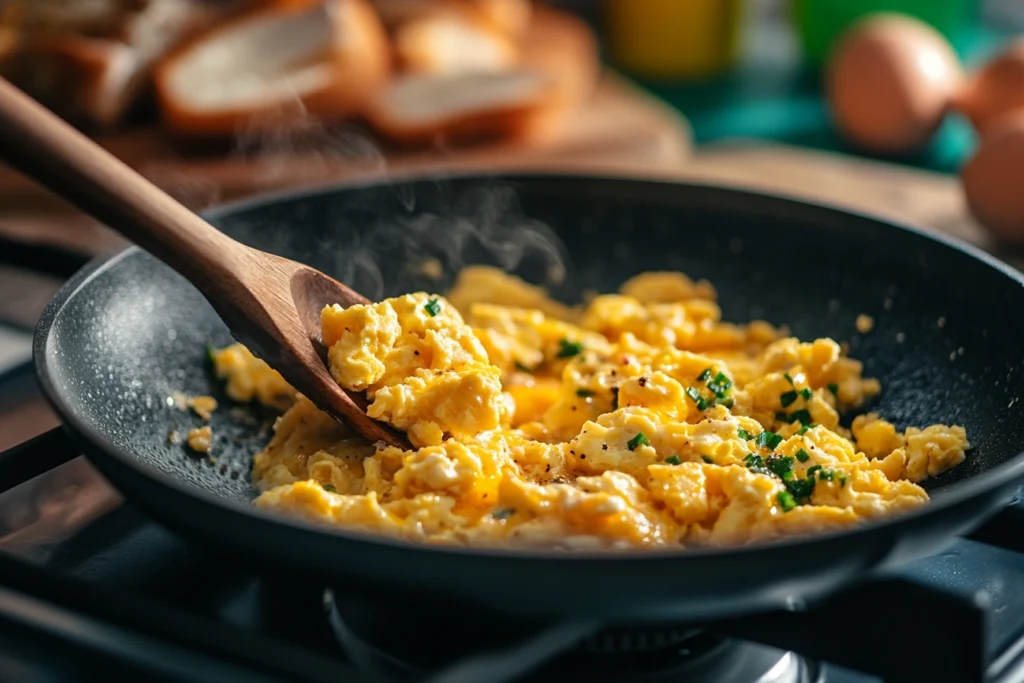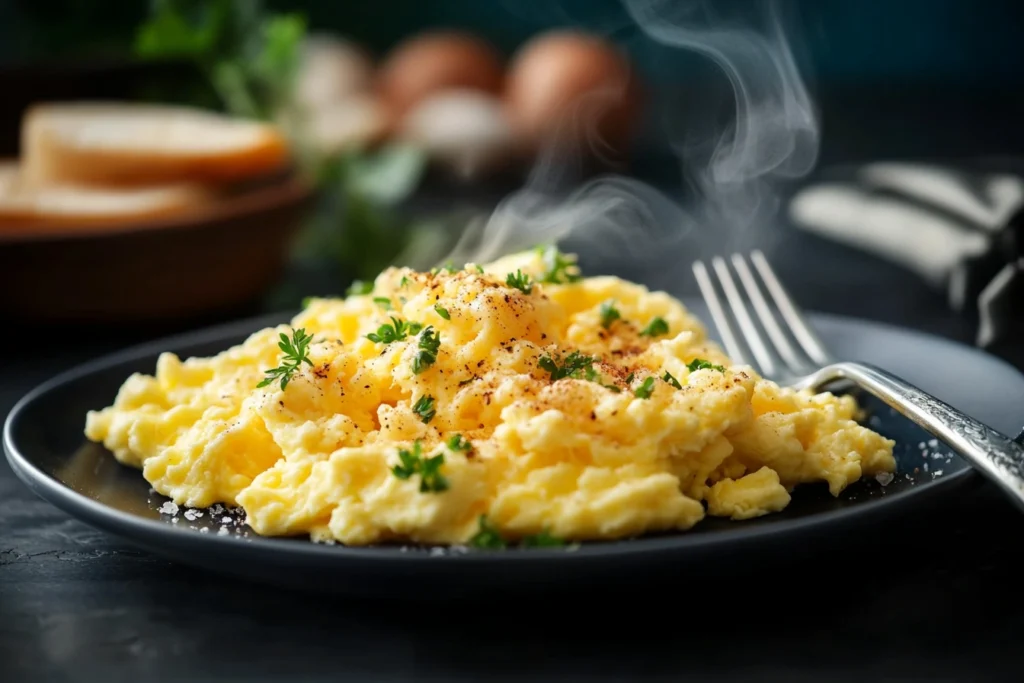Watery scrambled eggs can ruin your breakfast. Instead of creamy, fluffy eggs, you end up with a runny, unappetizing mess. Sound familiar? Don’t worry—you’re not alone! Many people struggle with runny scrambled eggs, but the good news is that it’s easy to fix once you know the right techniques.
In this guide, we’ll cover:
✔ The top reasons scrambled eggs turn watery
✔ How to fix watery scrambled eggs quickly
✔ Pro cooking techniques for soft, creamy, restaurant-quality scrambled eggs
Let’s get started and make sure you never have to deal with watery scrambled eggs again!

Table of Contents
PART 1: Why Are Your Scrambled Eggs Watery?
Before we fix the problem, we need to understand what’s causing it. Here are the most common reasons your scrambled eggs turn out too runny.
1. You’re Adding Too Much Liquid
Some people believe that adding milk, cream, or water to scrambled eggs makes them fluffier, but in reality, it often makes them watery scrambled eggs instead.
- Eggs naturally contain moisture, and as they cook, they release water.
- Adding extra milk, cream, or water increases moisture, making the eggs too wet.
- Instead of milk, try butter—it adds richness without making the eggs watery.
2. Cooking on Too High Heat
If you cook scrambled eggs on high heat, the proteins seize up too fast, squeezing out moisture. This leads to eggs that are dry yet watery at the same time.
- The best way to cook scrambled eggs? Low and slow.
- Set your stovetop to medium-low heat and cook the eggs gently for a softer, creamier texture.
3. Overcooking the Eggs
It sounds strange, but overcooked eggs can be watery too.
- When eggs cook for too long, they release excess water.
- The trick is to remove them from the heat just before they’re fully set—the residual heat will finish cooking them.
4. Not Beating the Eggs Properly
Scrambled eggs should have a smooth, uniform texture, but if you don’t whisk them properly, the whites and yolks don’t mix evenly.
- Solution? Beat the eggs thoroughly before cooking.
- A well-mixed egg blend ensures even cooking and a better texture.
5. Using the Wrong Pan
Believe it or not, your choice of pan plays a huge role in how your scrambled eggs turn out.
- Best pan for scrambled eggs: A nonstick skillet.
- Avoid stainless steel or cast iron unless well-greased, as eggs can stick and release moisture.
PART 2: 7 Easy Fixes for Watery Scrambled Eggs

Now that we know why scrambled eggs turn watery, let’s talk about how to fix them and get that perfect, fluffy texture every time.
Here are the best ways to prevent and fix watery scrambled eggs:
1. Skip the Milk—Use Butter Instead
A lot of people add milk or cream to their scrambled eggs, thinking it’ll make them fluffier. The truth? It often makes them watery instead.
- Eggs already contain moisture, so extra liquid isn’t necessary.
- Instead of milk, try butter—it adds richness and helps prevent excess water from pooling in the pan.
💡 Tip: If you love creamy eggs, add a teaspoon of sour cream or Greek yogurt after cooking instead of milk before cooking.
2. Beat the Eggs Thoroughly Before Cooking
If you don’t whisk your eggs well, the whites and yolks won’t combine properly, leading to uneven cooking and watery eggs.
✔ How to do it right:
- Use a fork or whisk to beat the eggs until fully mixed (about 30-60 seconds).
- The mixture should look smooth and uniform—no streaks of yolk or egg whites.
💡 Bonus Tip: Add a tiny pinch of baking powder before whisking for extra fluffiness!
3. Cook on Low Heat—Never High Heat
Eggs cook fast, and high heat can make them release water. Instead, go for low and slow cooking:
✔ How to do it right:
- Set your stovetop to medium-low heat (not high).
- Let the eggs cook gently without rushing them.
- Avoid turning the heat up, even if you’re in a hurry!
💡 Why this works: Low heat cooks the eggs evenly and prevents the proteins from tightening too quickly (which squeezes out water).
4. Stir Gently & Remove from Heat Early
If you stir too aggressively, the eggs break down and release extra moisture. Instead:
✔ How to do it right:
- Use a rubber spatula and fold the eggs gently instead of stirring vigorously.
- Remove the pan from heat when the eggs still look slightly undercooked—they’ll finish cooking from residual heat.
💡 Pro Tip: This method is called carryover cooking, and it helps eggs stay soft and creamy without becoming overcooked or watery.
5. Serve Immediately
One mistake people make? Letting scrambled eggs sit for too long.
✔ Why this matters:
- The longer eggs sit, the more they continue to release moisture.
- For the best texture, eat them immediately after cooking.
💡 Fix for watery eggs on your plate: If your eggs already turned watery, you can:
- Return them to low heat for a few seconds to evaporate the extra liquid.
- Drain the excess water using a paper towel before serving.
PART 3: How to Make Fluffy, Restaurant-Style Scrambled Eggs
Have you ever wondered why restaurant scrambled eggs are always so light, fluffy, and creamy? They somehow manage to get that perfect texture—never dry, never watery, just silky and rich.
Well, here’s the secret: it’s all in the technique! You don’t need fancy ingredients—just a few pro tips and tricks to make your scrambled eggs as good as (or better than!) your favorite diner’s.
1. Whisk the Eggs Like a Pro
Watery scrambled eggs often result from eggs that weren’t whisked well enough before cooking.
✔ How to do it right:
- Crack the eggs into a bowl and whisk them thoroughly for at least 30-60 seconds.
- The goal? Get the yolks and whites fully combined into a smooth, uniform mixture.
- The more air you whisk in, the fluffier the eggs will be.
💡 Chef’s Tip: If you want even fluffier eggs, add a pinch of baking powder or a tiny splash of club soda before whisking. This helps create extra air pockets for volume!
2. Use the Right Cooking Fat
Restaurants don’t use milk in their scrambled eggs—they use fat to create a rich, creamy texture.
✔ Best fats for scrambled eggs:
- Butter – The classic choice for soft, rich eggs.
- Olive oil – Adds a slightly nutty taste.
- Ghee – A clarified butter that gives eggs a deep, buttery flavor.
✔ How to do it right:
- Add 1 tablespoon of butter or oil to a nonstick pan before cooking.
- Let it melt on low heat before adding the eggs.
💡 Avoid: Using too much fat—it can make the eggs greasy instead of fluffy.
3. Cook on Low Heat (No Rushing!)
This is the most important step for restaurant-style eggs! High heat = disaster.
✔ How to do it right:
- Set your burner to low or medium-low heat.
- Pour the eggs into the pan and let them sit for 5-10 seconds before stirring.
- Stir slowly and gently push the eggs around with a rubber spatula.
💡 Why this works: Cooking on low heat keeps the eggs soft, creamy, and fluffy—just like they do in restaurants.
4. Stir Gently for a Soft, Custardy Texture
One of the biggest mistakes people make with scrambled eggs? Stirring too much or too aggressively!
✔ How to do it right:
- Instead of constant stirring, use a gentle folding motion with a rubber spatula.
- Push the eggs from the edges toward the center.
- This creates large, soft curds instead of tiny dry bits.
💡 Bonus Tip: Take the pan off the heat for a few seconds every now and then to prevent overcooking. This is how chefs keep their eggs soft and delicate.
5. Remove from Heat While They’re Still Slightly Soft
If you wait until your eggs look fully cooked in the pan, they’ll be overcooked by the time you eat them.
✔ How to do it right:
- Take the eggs off the heat when they’re still slightly wet-looking.
- They’ll continue cooking from residual heat in the pan for the perfect texture.
💡 Why this works: This technique keeps the eggs silky, soft, and never dry.
6. Add a Finishing Touch for Extra Creaminess
Want that extra creamy, restaurant-style taste? Stir in a little something at the very end.
✔ Best finishing touches for creamy eggs:
- A teaspoon of sour cream or crème fraîche
- A small cube of cold butter stirred in at the end
- A sprinkle of shredded cheese (cheddar, feta, or Parmesan)
💡 Pro Tip: Adding cream or butter at the end instead of before cooking gives eggs a velvety finish.
7. Season at the Right Time
Salt can mess up your scrambled eggs if you add it too early.
✔ How to do it right:
- Wait until the eggs are fully cooked before adding salt.
- Early salting draws out moisture, which can make eggs watery.
💡 Why this works: Adding salt at the end keeps the eggs fluffy and tender.
Conclusion
No one likes watery scrambled eggs, but now you know exactly how to fix them and prevent them from happening again. Remember:
✔ Whisk eggs well before cooking – More air = fluffier eggs.
✔ Cook on low heat – High heat forces out moisture.
✔ Skip the milk – It makes eggs runny instead of creamy.
✔ Use a nonstick pan – Prevents eggs from sticking and losing texture.
✔ Remove from heat early – Eggs will finish cooking off the stove.
By following these tips, you’ll never have to deal with watery scrambled eggs again!
For the ultimate scrambled egg experience, pair your eggs with the perfect side dish! If you love classic comfort foods, check out this fluffy homemade bread pudding with vanilla sauce for a delicious breakfast pairing.
FAQ
1. What to do if eggs are too runny?
If your scrambled eggs are too runny, don’t worry—there are a few easy ways to fix them.
✔ How to fix runny scrambled eggs:
Put them back on low heat – Stir gently until the extra moisture evaporates.
Tilt the pan and drain the liquid – Use a paper towel to soak up excess water.
Add cheese or breadcrumbs – A small amount can help absorb extra moisture.
💡 Prevent it next time: Avoid adding too much milk, cook on low heat, and remove from heat before they look fully cooked.
2. How do you add texture to scrambled eggs?
If you love scrambled eggs with texture, try these tricks:
✔ Best ways to improve texture:
Whisk the eggs well – This ensures a smooth, even consistency.
Use butter or ghee instead of milk – Adds richness without making eggs watery.
Cook on low heat and stir gently – Creates soft, creamy curds.
Add mix-ins for texture – Cheese, sautéed veggies, crispy bacon, or fresh herbs.
💡 Secret Trick: A tiny pinch of baking powder before whisking makes eggs extra fluffy!
3. How to get liquid out of eggs?
If you accidentally made watery scrambled eggs, you can fix them by removing excess liquid.
✔ Best ways to remove liquid from eggs:
Return the eggs to low heat and stir gently until moisture evaporates.
Tilt the pan and drain excess liquid onto a paper towel.
Stir in grated cheese or a teaspoon of cornstarch to absorb extra moisture.
💡 Avoid watery eggs next time by: Cooking on low heat, skipping milk, and removing eggs from the pan before they look fully set.


1 thought on “5 Easy Fixes for Watery Scrambled Eggs – Get Perfect Fluffiness!”